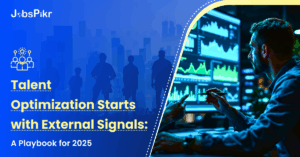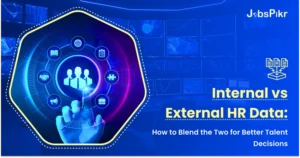- Understanding Labor Market Trends: A Strategic Advantage
- From Historic Hiring to Forward-Looking Demand Models
- Avoiding Over-Hiring with Smart Demand Forecasting
- Filling Skill Gaps Faster with Labor Market Intelligence
- Location Strategy: Planning Where to Hire with Confidence
- Aligning Internal Workforce Data with External Labor Trends
- Navigating Economic Shifts with Real-Time Job Growth Data
- Empowering CHROs and HR Leaders with Planning Precision
- Final Thoughts: Planning with Precision in a New Talent Landscape
Why Labor Market Forecasting Matters More Than Ever? The way companies plan their workforce is changing rapidly. What used to be a straightforward headcount forecast is now a complex, high-stakes exercise in agility, insight, and speed. With business needs shifting constantly and talent markets becoming more competitive and unpredictable, traditional workforce planning no longer cuts it.
Today, HR leaders, CHROs, and market analysts need real-time insights and reliable forecasting tools. That’s where labor market trends come in. By analyzing patterns in hiring, job growth, skill requirements, and regional supply-demand dynamics, companies can plan with far greater precision. They can predict not just how many people they’ll need—but also where, when, and with what skills.
In this article, we’ll explore how enterprise HR teams are using labor market data and forecasting models to build future-ready talent strategies. We’ll also examine how combining external insights with internal analytics helps prevent over-hiring, close skills gaps faster, and optimize global workforce planning.
Understanding Labor Market Trends: A Strategic Advantage
In the past, labor market data was treated as a general economic indicator—something for policymakers and economists to worry about. But that’s no longer the case. For modern enterprises, tracking labor market trends has become a strategic necessity.
Here’s why: The job market is in constant motion. Skills that were in high demand a year ago may already be outdated. Entire functions are being restructured, remote work has transformed location strategies, and automation is redefining roles across industries.
By analyzing labor market signals—such as job posting volumes, compensation trends, hiring velocity, and employer demand—HR teams can stay ahead of the curve. These trends help companies:
- Benchmark internal talent needs against industry shifts
- Identify emerging skills early
- Spot geographical opportunities or constraints
- Optimize compensation and benefits strategies
Take the US labor market trends as an example. In 2024, the U.S. saw a noticeable rebound in demand for green energy roles, cybersecurity professionals, and logistics talent. Companies that tracked these changes were able to proactively adjust their recruiting strategies—rather than play catch-up. According to the U.S. Bureau of Labor Statistics, the unemployment rate stood at 4.2% in March 2025 (source).
Platforms like JobsPikr aggregate and analyze labor market data at scale, giving enterprise teams the visibility they need to forecast with confidence.
From Historic Hiring to Forward-Looking Demand Models
Many HR teams still rely heavily on historical hiring patterns to forecast future needs. While that can be helpful for spotting long-term trends, it’s not enough to stay competitive in today’s fast-moving markets.
Instead, leading organizations are moving to predictive workforce planning models that combine internal talent data with external labor market analysis. These models use machine learning and AI to project job role demand based on:
- Business growth forecasts
- Skills inventory and gaps
- External job market behavior
- Attrition risks and workforce aging
For example, if a healthcare firm is planning to expand its telehealth services, a predictive model can analyze job growth data in similar firms, identify skill shortages in digital care roles, and recommend where to start hiring—or retraining—first.
When companies make planning decisions based on real-time data rather than outdated metrics, they reduce hiring risks, improve agility, and increase ROI on talent investments.
Avoiding Over-Hiring with Smart Demand Forecasting
One of the biggest challenges in workforce planning is avoiding the trap of over-hiring. It happens more often than we realize—especially when growth plans are built on assumptions rather than real data.
Over-hiring leads to unnecessary payroll costs, operational inefficiencies, and potential layoffs that can harm employee morale and brand reputation. The solution? Better forecasting.
When HR leaders use labor market trends and internal analytics together, they gain visibility into true talent demand. They can simulate hiring scenarios, evaluate different growth models, and understand which roles are critical—and which are nice to have.
Let’s say a SaaS company sees a spike in customer acquisition. The immediate reaction might be to ramp up customer support teams. But with proper labor market analysis, they might discover that automating certain functions and investing in customer success software could meet the same need with fewer hires.
This kind of insight is only possible when planning is guided by precision, not pressure. JobsPikr helps HR teams monitor hiring benchmarks in their industry, track regional demand fluctuations, and build hiring plans that scale efficiently and responsibly.
Business Insider highlighted 20 high-paying occupations in the U.S. with strong projected job growth through 2033, based on data from the Bureau of Labor Statistics (Source).

Filling Skill Gaps Faster with Labor Market Intelligence
Every company faces skills gaps. But not every company has the visibility or tools to fill them quickly.
That’s where labor market trends play a crucial role. By mapping job growth data and tracking which skills are trending up or down, companies can stay ahead of the curve. They can also spot where talent pools are rich—and where competition is fierce.
For example, if you’re hiring for data engineering roles, labor market data can show:
- Which cities have the highest concentration of qualified talent
- What salary ranges are competitive
- Which companies are hiring for similar roles (and how fast)
- What adjacent skills are emerging (like cloud security or AI frameworks)
Armed with this information, HR teams can prioritize markets, adjust job descriptions, and fast-track recruiting efforts.

Throughout 2024 and early 2025, the labor force participation rate remained in a narrow range of 62.4% to 62.7%, standing at 62.5% in March 2025 (Source).
JobsPikr’s market intelligence platform lets users drill down into granular data like job title trends, skills in demand, and competitor activity—helping enterprises move faster and smarter when closing skill gaps.
Location Strategy: Planning Where to Hire with Confidence
It’s not just about who to hire—but where.
With the rise of remote and hybrid work, location strategy has become a critical part of workforce planning. Companies are no longer restricted to local talent pools, but they’re also dealing with new complexities around regional compensation, legal compliance, and team collaboration.
Using labor market analysis, HR teams can evaluate:
- Where specific roles are in high supply or short supply
- How wages vary across cities or countries
- Which regions offer favorable hiring conditions
- What competitor activity looks like in targeted geographies
For instance, if your engineering team is struggling to hire in California, labor market data might suggest expanding the search to Toronto or Austin—where job growth is strong, but competition is less intense.
JobsPikr helps enterprises create location-specific job market dashboards, enabling them to assess new markets in real-time and design smarter, more cost-effective location strategies.

Aligning Internal Workforce Data with External Labor Trends
Internal HR data—like turnover, performance metrics, and training effectiveness—tells you what’s happening inside your company. But it doesn’t always show how you compare to the rest of the market.
That’s why combining internal and external data is so important. It creates a 360-degree view of workforce readiness and market competitiveness.
Here’s how this integration helps:
- If your attrition rate is high, you can check if other companies in your industry are facing the same issue—perhaps it’s a market-wide shift.
- If promotions are lagging for certain roles, labor market data might reveal that competitors are offering faster growth paths—prompting a change in your internal mobility strategy.
- If your training program isn’t closing skill gaps fast enough, external benchmarks can guide improvements in curriculum or learning formats.
JobsPikr’s API allows companies to layer real-time market data onto internal dashboards, giving HR teams the context they need to act faster, smarter, and more strategically.
Navigating Economic Shifts with Real-Time Job Growth Data
Labor markets are directly influenced by broader economic conditions. A recession, geopolitical conflict, or industry-specific disruption can quickly change the demand for talent.
By tracking job growth and hiring trends in real time, companies can adjust their workforce strategy to reflect new realities. For example:
- During a slowdown, firms might pause hiring for non-critical roles, focus on internal mobility, or shift to contract-based staffing.
- During a boom, rapid hiring in key functions (e.g., product development or sales) may require pre-emptive sourcing and competitive compensation.
JobsPikr provides access to up-to-date hiring data across industries, allowing companies to track demand shifts, monitor peer activity, and respond quickly to changing labor dynamics.
This agility helps enterprises weather uncertainty while continuing to grow their workforce in sustainable ways.
Empowering CHROs and HR Leaders with Planning Precision
CHROs and HR leaders today are expected to deliver more than just staffing plans—they’re expected to provide strategic guidance, shape organizational resilience, and align talent with enterprise goals.
That’s only possible with data.
With access to reliable labor market trends and smart forecasting models, HR teams can:
- Present data-backed workforce plans to the executive team
- Advocate for investment in upskilling and internal development
- Support location planning and cost optimization strategies
- Reduce risks in global expansion or restructuring
In short, labor market intelligence helps HR leaders earn their seat at the strategic table. Platforms like JobsPikr are essential partners in that journey—offering enterprise-grade insights that drive better talent outcomes across the board.
Final Thoughts: Planning with Precision in a New Talent Landscape
We’ve entered a new era of workforce planning—one that demands accuracy, speed, and deep market awareness. Guesswork and outdated models are no longer enough to compete in a fast-changing world of work.
By integrating labor market trends, internal workforce analytics, and AI-powered forecasting tools, enterprise HR leaders can transform the way they plan, hire, and grow.
They can anticipate job role demand before it spikes, identify skill gaps while there’s still time to fill them, and design workforce structures that are as agile as the markets they serve.If you’re ready to plan with precision, sign up on JobsPikr. Our platform provides real-time labor market data, predictive insights, and enterprise intelligence tools designed to power the future of workforce planning—so you’re never caught off guard.




